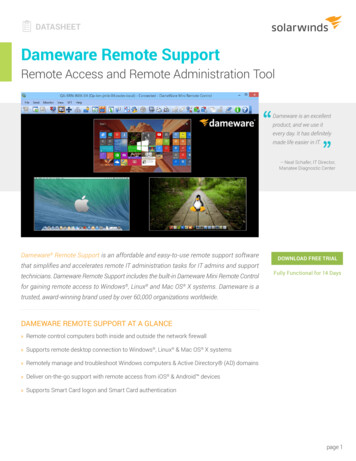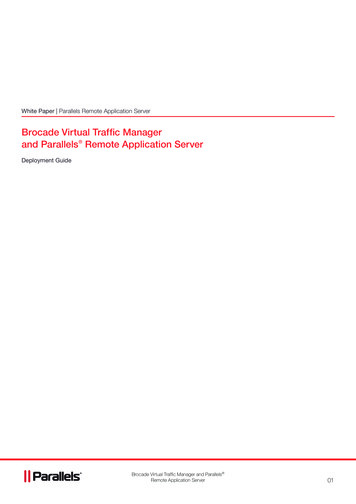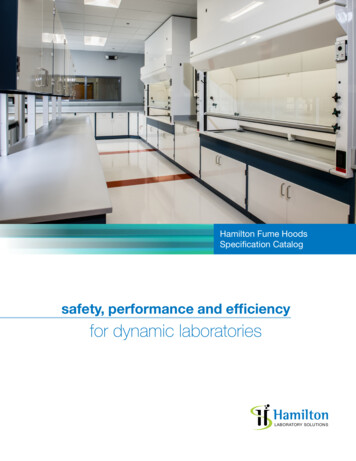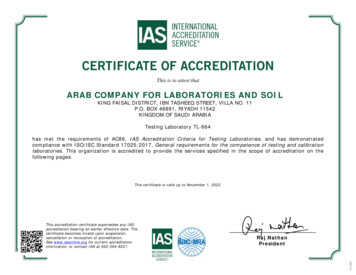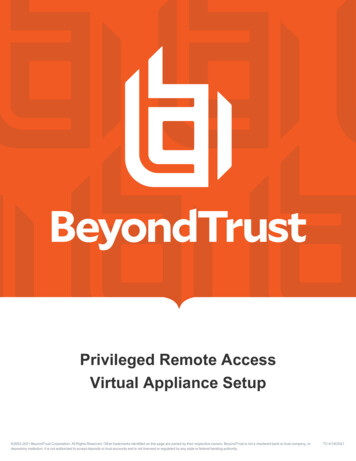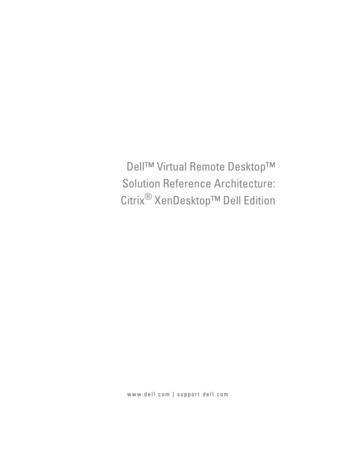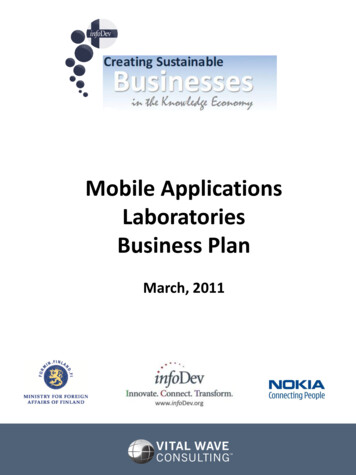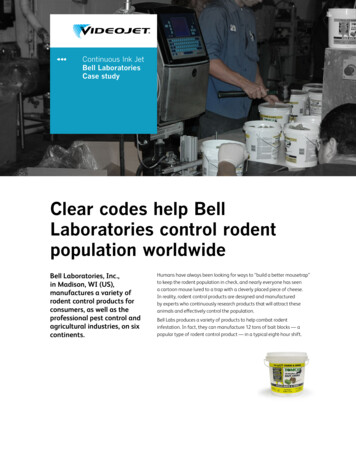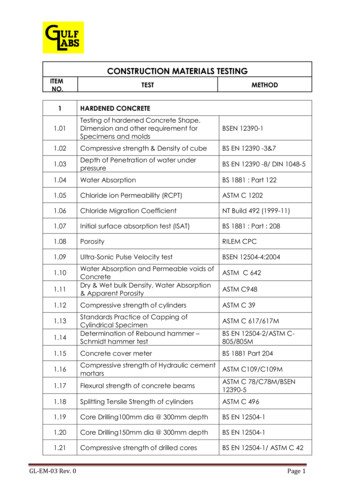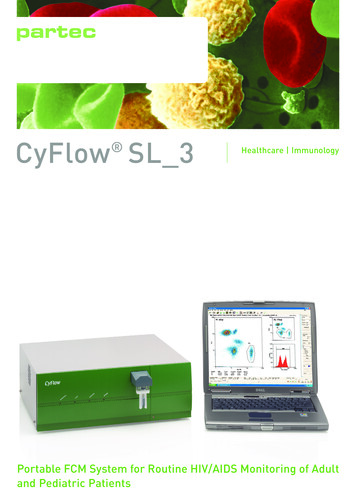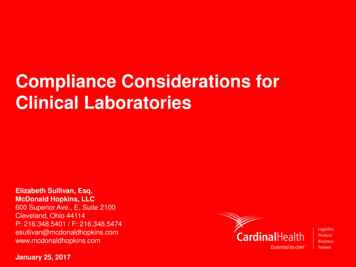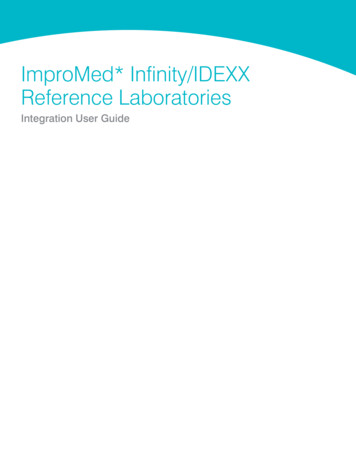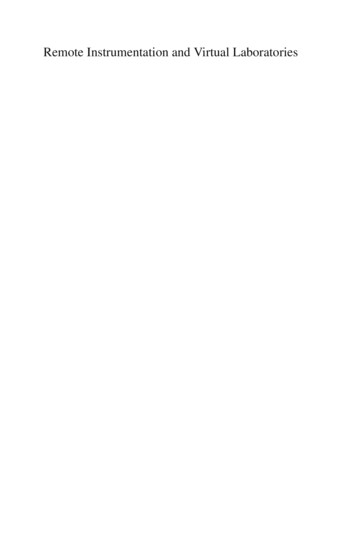
Transcription
Remote Instrumentation and Virtual Laboratories
Franco Davoli · Norbert Meyer · Roberto Pugliese ·Sandro ZappatoreEditorsRemote Instrumentationand Virtual LaboratoriesService Architecture and Networking123
EditorsFranco DavoliUniversity of GenoaDISTVia Opera Pia, 1316145 GenovaItalyfranco@dist.unige.itRoberto PuglieseSincrotrone Trieste S.p.A.Strada Statale14 km 163.5 in Area Science Park34012 ste.itNorbert MeyerPoznań Supercomputing &Networking Centerul. Noskowskiego 1061-704 PoznańPolandmeyer@man.poznan.plSandro ZappatoreUniversity of GenoaDISTVia Opera Pia, 1316145 GenovaItalyISBN 978-1-4419-5595-1e-ISBN 978-1-4419-5597-5DOI 10.1007/978-1-4419-5597-5Springer New York Dordrecht Heidelberg LondonLibrary of Congress Control Number: 2010921156c Springer Science Business Media, LLC 2010 All rights reserved. This work may not be translated or copied in whole or in part without the writtenpermission of the publisher (Springer Science Business Media, LLC, 233 Spring Street, New York,NY 10013, USA), except for brief excerpts in connection with reviews or scholarly analysis. Use inconnection with any form of information storage and retrieval, electronic adaptation, computersoftware, or by similar or dissimilar methodology now known or hereafter developed is forbidden.The use in this publication of trade names, trademarks, service marks, and similar terms, even ifthey are not identified as such, is not to be taken as an expression of opinion as to whether or notthey are subject to proprietary rights.Printed on acid-free paperSpringer is part of Springer Science Business Media (www.springer.com)
PrefaceeScience is generally recognized as a complex of activities that require highly intensive computation on huge data sets in a large-scale networked distributed environment. It embraces such diverse disciplines as particle and high-energy physics,meteorology, astronomy, astrophysics, geo-science, and biology, just to mention afew. Another essential component of such activities is the capability of real-timeinteraction and collaboration among many scientists working on a specific problemor data set worldwide. However, there is a third major aspect that is sometimesless emphasized in this context, which is related with the use of specific instrumentation – the pieces of equipment physically producing the data that pertain to acertain experiment. Remotely accessing instruments, configuring their parameters,setting up a “measurement chain” – possibly distributed among different laboratories, running the experiment, generating and collecting the data are all preliminaryactions to any further activities regarding data analysis and interpretation. Systemlevel science and effectively running the complex workflows that modern sciencerequires are made possible only by integrating instruments in the computing anddata treatment pipeline.In turn, large data sets and computationally intensive operations of eScienceinvolve the use of Grid computing paradigms and their middleware. Bringing instrumentation into this framework raises new problems and challenges. What new middleware components and functionalities are needed to expose instruments as anyother resources in the eInfrastructure? Which abstractions can better represent themultiplicity of scientific instruments and laboratory equipment? How and to whatextent does the distributed environment affect measurement precision? These andother issues arise that require attention and answers. Even more than with otheraspects in distributed systems, dealing with remote instrumentation to set up realand usable Remote Instrumentation Services (RIS) involves the multi-disciplinaryinteraction among computer science, networking, and metrology.This is the third book in this series that attempts to put together such different points of view in the field of Remote Instrumentation. The first one (Distributed Cooperative Laboratories: Networking, Instrumentation, and Measurements, Springer, New York, 2006; ISBN 0-387-29811-8) was less focused on theintegration of instruments and laboratories in the Grid and rather more concentratedon networking and measurement aspects. The second one (Grid-Enabled Remotev
viPrefaceInstrumentation, Springer, New York, 2008; ISBN 978-0-387-09662-9) set forththe architectural and middleware aspects, though not neglecting the other relevantdimensions. In the present volume, we continue pursuing this point of view, withgreater emphasis on the eInfrastructure in support of RIS and its features.All books stemmed from a series of workshops on Distributed Cooperative Laboratories, which have converged under the name INGRID (“Instrumenting” the Grid),all held so far in Italy in different locations. The contributions in this book areextended and revised versions of presentations at INGRID 2008 (http://www.ingrid08.cnit.it), which took place in Lacco Ameno, Ischia, Italy, fromApril 9 to 11, 2008. Since the beginning, the INGRID Workshops were organizedwithin the framework of a number of different European research projects. Amongothers, GRIDCC (Grid enabled Remote Instrumentation with Distributed Controland Computation), int.eu.grid (Interactive European Grid), g-Eclipse, CoreGRID,EDGeS (Enabling Desktop Grids for e-Science), EXPReS (Express ProductionReal-time e-VLBI Service), EGI (European Grid Initiative), DORII(Deployment of Remote Instrumentation Infrastructure), and RINGrid (RemoteInstrumentation in Next-generation Grids) provided some of the results that aredescribedherein.The material in the book is organized in seven parts, each containing a numberof articles. Part I, Remote Instrumentation Services, presents an overview of theactivities of the RISGE (Remote Instrumentation Services in Grid Environment)Research Group (http://forge.ogf.org/sf/projects/risge-rg) ofthe OGF (Open Grid Forum), followed by a description of the Instrument Element(IE) – one of the main components to provide Grid-enabled instrumentation, andof some specific use cases in high-energy physics, telecommunication measurementequipment, and genomics.Part II, Grid Infrastructure, Services, and Applications, after a short presentationof the structure and scope of the EGI, deals with Grid-specific functionalities thatare relevant also to RIS, besides other services: automatic service deployment, jobscheduling, Quality of Service (QoS) provisioning, resource management, globalservices across multiple Grids, desktop Grids, soft real-time constraints. The partpresents also two applications in electron microscopy and simulation of a biophysical phenomenon.Part III is entirely dedicated to Interactivity Services, an important aspect toprovide the operator with the capability of online controlling the instrumentation and the experiment execution. Several aspects are considered, from the coexistence of parallel and interactive jobs to interactive data visualization, amongothers.Part IV touches upon some Supporting Services. These include middleware independence, context-aware service composition, synchronization, resource discoverybased on Specific Service Agreements (SLAs), QoS across multiple networkingdomains, and the use of portals in a specific application environment.
PrefaceviiPart V addresses some large-scale instrumentation for radio astronomy, namelye-VLBI (electronic Very Large Baseline Interferometry) and Cosmic Rays Detection, treating both computational and networking aspects.In Part VI, Metrology Issues are considered in some detail. They include wirelessnetworking and synchronization in distributed measurement systems, as well as thedescription of some educational applications in remote instrumentation.Finally, Part VII is devoted to Wireless Sensor Networks for Measurement. Wireless Sensor Networks (WSNs) are a fundamental component of Remote Instrumentation Services and constitute the basis for data acquisition in many distributedapplications. The contributions in this part cover aspects in signal processing,data aggregation, energy saving, and integration of WSNs in the Service-OrientedArchitecture.Franco DavoliNorbert MeyerRoberto PuglieseSandro Zappatore
AcknowledgmentsWe gratefully acknowledge the support of the many persons and institutions thatcontributed to the success of the third Workshop on Distributed Cooperative Laboratories (INGRID 2008) and to this book. The European Commission, through theDirectorate General for Information Society and Media (DG-INFSO), and in particular the Research Infrastructures Unit, has funded most of the projects that supported the research lines covered by this book. Our thanks and appreciation go to thekeynote speakers, Prof. Ian Foster, Argonne National Laboratories and the University of Chicago, USA, and Dr. Maria Ramalho-Natario, DG-INFSO. Thanks are duealso to the session organizers (Jesus Marco de Lucas, IFCA-CSIC, Spain; T. CharlesYun, JIVE, The Netherlands; Luigino Benetazzo, University of Padova, Italy; MarcinPłóciennik, PSNC, Poland; Dieter Kranzlmueller, LMU Munich, Germany; PerÖster, CSC, Finland; Tatsuya Suda, UCI, USA; Marcin Lawenda, PSNC, Poland),Program Committee members, authors and presenters, as well as to Clotilde FertiniCanepa for the logistic organization, to Stefano Vignola and Carlo Caligaris forcarefully checking and formatting the manuscript, and to the Springer editorial staff.Last but not least, we are grateful to Agilent Technologies, Selex Communications,and SIR S.r.l. for their sponsorship of the event.ix
ContentsPart I Remote Instrumentation Services1 Open Grid Forum Research Group: Remote InstrumentationServices in Grid Environment – Overview of Activities . . . . . . . . . . . . .M. Płóciennik and R. Pugliese32 Adapting the Instrument Element to Support a RemoteInstrumentation Infrastructure . . . . . . . . . . . . . . . . . . . . . . . . . . . . . . . . . 11M. Prica, R. Pugliese, A. Del Linz, and A. Curri3 Performance Analysis of a Grid-Based Instrumentation DeviceFarm . . . . . . . . . . . . . . . . . . . . . . . . . . . . . . . . . . . . . . . . . . . . . . . . . . . . . . . . . 23L. Berruti, F. Davoli, S. Vignola, and S. Zappatore4 Experimental Characterization of Wireless and Wired Accessin Distributed Laboratories . . . . . . . . . . . . . . . . . . . . . . . . . . . . . . . . . . . . . 33R. Soloperto, A. Conti, D. Dardari, and O. Andrisano5 Virtual Laboratory and Its Application in Genomics . . . . . . . . . . . . . . . 43L. Handschuh, M. Lawenda, N. Meyer, P. Stȩpniak, M. Figlerowicz,M. Stroiński, and J. WȩglarzPart II Grid Infrastructure, Services, and Applications6 The European Grid Initiative (EGI) . . . . . . . . . . . . . . . . . . . . . . . . . . . . . 61D. Kranzlmüller, J. Marco de Lucas, and P. Öster7 Virtual Appliances: A Way to Provide Automatic ServiceDeployment . . . . . . . . . . . . . . . . . . . . . . . . . . . . . . . . . . . . . . . . . . . . . . . . . . . 67G. Kecskemeti, P. Kacsuk, T. Delaitre, and G. Terstyanszkyxi
xiiContents8 Job Scheduling in Hierarchical Desktop Grids . . . . . . . . . . . . . . . . . . . . 79Z. Farkas, A.Cs. Marosi, and P. Kacsuk9 Toward QoS Provision for Virtualized Resources in Grids . . . . . . . . . . 99F. Rodríguez-Haro, F. Freitag, and L. Navarro10 From Grid Islands to a World Wide Grid . . . . . . . . . . . . . . . . . . . . . . . . . 109P. Kacsuk and T. Kiss11 The Anatomy of Grid Resource Management . . . . . . . . . . . . . . . . . . . . . 123A. Kertész and T. Prokosch12 SZTAKI Desktop Grid: Adapting Clusters for Desktop Grids . . . . . . . . 133A.Cs. Marosi, Z. Balaton, P. Kacsuk, and D. Drótos13 SoRTGrid: A Grid Framework Compliant with Soft Real-TimeRequirements . . . . . . . . . . . . . . . . . . . . . . . . . . . . . . . . . . . . . . . . . . . . . . . . . . 145A. Merlo, A. Clematis, A. Corana, D. D’Agostino, V. Gianuzzi,and A. Quarati14 A Data Grid Architecture for Real-Time Electron MicroscopyApplications . . . . . . . . . . . . . . . . . . . . . . . . . . . . . . . . . . . . . . . . . . . . . . . . . . 163F. Mighela and C. Perra15 A Network-Aware Grid for Efficient Parallel Monte CarloSimulation of Coagulation Phenomena . . . . . . . . . . . . . . . . . . . . . . . . . . . 173M. Marchenko, D. Adami, C. Callegari, S. Giordano, and M. PaganoPart III Interactivity Management16 Practical Mechanisms for Managing Parallel and Interactive Jobson Grid Environments . . . . . . . . . . . . . . . . . . . . . . . . . . . . . . . . . . . . . . . . . 191E. Fernández, E. Heymann, and M.A. Senar17 Int.eu.grid . . . . . . . . . . . . . . . . . . . . . . . . . . . . . . . . . . . . . . . . . . . . . . . . . . . . 201G. Borges, J. Gomes, M. Montecelo, M. David, B. Silva, N. Dias,J.P. Martins, C. Fernández, L. García-Tarrés, C. Veiga, D. Cordero,J. López, J. Marco, I. Campos, D. Rodriguez, R. Marco, A. López,P. Orviz, A. Hammad, M. Hardt, E. Fernández, E. Heymann,M.A. Senar, A. Padee, K. Nawrocki, W. Wislicki, P. Heinzlreiter,M. Baumgartner, H. Rosmanith, S. Kenny, B. Coghlan, P. Lason,L. Skital, J. Astalos, M. Ciglan, M. Pospieszny, R. Valles, andK. Dichev
Contentsxiii18 Interactivity in Grid Computing in the Presence of Web Services . . . . 211H. Rosmanith and J. Volkert19 Fusion Simulations, Data Visualization Results and FutureRequirements for the Interactive Grid Infrastructure . . . . . . . . . . . . . . 225F. Castejón, D. Lopez-Bruna, J.M. Reynolds, A. Tarancón, R. Valles,and J.L. Velasco20 Interactive Grid-Access Using MATLAB . . . . . . . . . . . . . . . . . . . . . . . . . 235M. Hardt, M. Zapf, and N.V. Ruiter21 Collaborative Interactivity in Parallel HPC Applications . . . . . . . . . . . 249M. Riedel, W. Frings, T. Eickermann, S. Habbinga, P. Gibbon, A. Streit,F. Wolf, and T. Lippert22 Interactive and Real-Time Applications on the EGEE GridInfrastructure . . . . . . . . . . . . . . . . . . . . . . . . . . . . . . . . . . . . . . . . . . . . . . . . . 263E. Floros and C. LoomisPart IV Supporting Services23 g-Eclipse – A Middleware-Independent Framework for AccessingExisting Grid Infrastructures . . . . . . . . . . . . . . . . . . . . . . . . . . . . . . . . . . . 277M. Stümpert, H. Kornmayer, and M. Knauer24 Semantics-Based Context-Aware Dynamic Service Composition . . . . . 293K. Fujii and T. Suda25 Distributed e-Science Application for Computational SpeechScience . . . . . . . . . . . . . . . . . . . . . . . . . . . . . . . . . . . . . . . . . . . . . . . . . . . . . . . 313K. Nozaki, K. Baba, M. Noro, M. Nakagawa, S. Date, and S. Shimojo26 SynchroNet . . . . . . . . . . . . . . . . . . . . . . . . . . . . . . . . . . . . . . . . . . . . . . . . . . . 327E. Varriale, D. Cretoni, F. Gottifredi, and M. Gotta27 Discovery of Resources in a Distributed Grid Environment Basedon Specific Service Level Agreements (SLAs) . . . . . . . . . . . . . . . . . . . . . 343D. Kollia, S. Kafetzoglou, M. Grammatikou, and S. Papavassiliou28Inter-Domain SLA Enforcement in QoS-Enabled Networks . . . . . . . . . 351C. Marinos, V. Pouli, M. Grammatikou, and V. Maglaris
xivContentsPart V eVLBI and Cosmic Rays Detection29 High-Bandwidth Data Acquisition and Network Streamingin VLBI . . . . . . . . . . . . . . . . . . . . . . . . . . . . . . . . . . . . . . . . . . . . . . . . . . . . . . . 363J. Wagner, G. Molera, and M. Uunila30 Real-Time Software Correlation . . . . . . . . . . . . . . . . . . . . . . . . . . . . . . . . . 375N.G.H. Kruithof and D.C.P.M. Marchal31 AugerAccess – Virtual Infrastructure for Simulating ComplexNetworks . . . . . . . . . . . . . . . . . . . . . . . . . . . . . . . . . . . . . . . . . . . . . . . . . . . . . 387M. Sutter, H.-J. Mathes, K. Daumiller, T. Jejkal, R. Stotzka,A. Kopmann, and H. GemmekePart VI Metrology Issues32 Challenges and Design Issues in a Distributed MeasurementScenario . . . . . . . . . . . . . . . . . . . . . . . . . . . . . . . . . . . . . . . . . . . . . . . . . . . . . . 405L. Benetazzo, M. Bertocco, G. Gamba, and A. Sona33 The Distributed Measurement Systems: A New Challengefor the Metrologists . . . . . . . . . . . . . . . . . . . . . . . . . . . . . . . . . . . . . . . . . . . . 417A. Ferrero and R. Ottoboni34 Recent Progresses of the Remote Didactic Laboratory LA.DI.RE“G. Savastano” Project . . . . . . . . . . . . . . . . . . . . . . . . . . . . . . . . . . . . . . . . . 427P. Daponte, D. Grimaldi, and S. Rapuano35 A Software Architecture for the m-Learning in Instrumentationand Measurement . . . . . . . . . . . . . . . . . . . . . . . . . . . . . . . . . . . . . . . . . . . . . . 443P. Daponte, D. Grimaldi, and S. RapuanoPart VII Sensor Networks for Measurement36 Performance of Linear Field Reconstruction Techniques with Noiseand Correlated Field Spectrum . . . . . . . . . . . . . . . . . . . . . . . . . . . . . . . . . . 459A. Nordio, G. Alfano, and C.F. Chiasserini37 Hybrid Zigbee–RFID Networks for Energy Saving and LifetimeMaximization . . . . . . . . . . . . . . . . . . . . . . . . . . . . . . . . . . . . . . . . . . . . . . . . . 473P. Medagliani, G. Ferrari, and M. Marastoni
Contentsxv38 A Service-Oriented Wireless Sensor Network for Power Metering . . . 493A. Bagnasco, P. Buschiazzo, L. Carlino, and A.M. Scapolla39 Performance Evaluation of a Robust Data Aggregation Approachin Diverse Sensor Networking Environments . . . . . . . . . . . . . . . . . . . . . . 501S. Kafetzoglou, M. Grammatikou, and S. PapavassiliouAuthor Index . . . . . . . . . . . . . . . . . . . . . . . . . . . . . . . . . . . . . . . . . . . . . . . . . . . . . . 513Subject Index . . . . . . . . . . . . . . . . . . . . . . . . . . . . . . . . . . . . . . . . . . . . . . . . . . . . . . 517
ContributorsD. Adami CNIT Research Unit, Department of Information Engineering,University of Pisa, Italy, d.adami@iet.unipi.itG. Alfano Politecnico di Torino, Corso Duca degli Abruzzi 24, I-10129,Torino, Italy, giuseppa.alfano@polito.itO. Andrisano WiLAB, University of Bologna, Viale Risorgimento 2, 40136Bologna, Italy, o.andrisano@ieee.orgJ. Astalos Institute of informatics, Slovak academy of sciences, Bratislava,Slovakia, astalos.ui@savba.skK. Baba Cybermedia Center, Osaka University, Japan; Graduate School ofInformation Science and Technology, Osaka University, Japan; National Instituteof Information and Communication Technology, Japan, baba@cmc.osaka-u.ac.jpA. Bagnasco DIBE – University of Genoa, 16145 Genova, Italy,andrea.bagnasco@unige.itZ. Balaton MTA SZTAKI, Computer and Automation Research Institute,Hungarian Academy of Sciences, H-1528 Budapest, Hungary, balaton@sztaki.huM. Baumgartner GUP Linz, Joh. Kepler University, Linz, Austria, mb@gup.jku.atL. Benetazzo Department of Information Engineering, University of Padova,35131 Padova, Italy, luigino.benetazzo@unipd.itL. Berruti CNIT – University of Genoa Research Unit, 16145 Genova, Italy,luca.berruti@cnit.itM. Bertocco Department of Information Engineering, University of Padova,35131 Padova, Italy, matteo.bertocco@unipd.itG. Borges Laboratòrio de Instrumentação e Física Experimental de Partículas,Lisboa, Portugal, goncalo@lip.ptP. Buschiazzo DIBE – University of Genoa, 16145 Genova, Italy,paolo.buschiazzo@unige.itxvii
xviiiContributorsC. Callegari Department of Information Engineering, University of Pisa, Italy,christian.callegari@iet.unipi.itI. Campos Instituto de Física de Cantabria, IFCA, CSIC-UC, Santander, Spain,iscampos@ifca.unican.esL. Carlino DIBE – University of Genoa, 16145 Genova, Italy,luca.carlino@unige.itF. Castejón Instituto de Biocomputación y Física de Sistemas Complejos.Universidad de Zaragoza, 50009 Zaragoza, Spain; Laboratorio Nacional de Fusión –Asociación Euratom/Ciemat, 28040-Madrid, Spain, francisco.castejon@ciemat.esC.F. Chiasserini Politecnico di Torino, Corso Duca degli Abruzzi 24, I-10129,Torino, Italy, chiasserini@polito.itM. Ciglan Institute of Informatics, Slovak Academy of Sciences, Bratislava,Slovakia, marek.ciglan@savba.skA. Clematis IMATI-CNR, Via De Marini 6, 16149 Genova, Italy,clematis@ge.imati.cnr.itB. Coghlan Trinity College Dublin, Dublin, Ireland, brian.coghlan@tcd.ieA. Conti WiLAB, University of Bologna, Viale Risorgimento 2, 40136 Bologna,Italy; ENDIF, University of Ferrara, Italy, a.conti@ieee.orgA. Corana IEIIT-CNR, Via De Marini 6, 16149 Genova, Italy, corana@ieiit.cnr.itD. Cordero Centro de Supercomputación de Galicia, Santiago deCompostela, Spain, dcordero@cesga.esD. Cretoni Thales Alenia Space Italia S.p.A., Roma, Italy,daniele.cretoni@thalesaleniaspace.comA. Curri Sincrotrone Trieste S.C.p.A., Strada Statale per Basovizza 14, 34012Trieste, Italy, alessio.curri@elettra.trieste.itD. D’Agostino IMATI-CNR, Via De Marini 6, 16149 Genova, Italy,daniele.dagostino@ge.imati.cnr.itP. Daponte Department of Engineering, University of Sannio, Corso Garibaldi107, 82100 Benevento, Italy, daponte@unisannio.itD. Dardari WiLAB, University of Bologna, Viale Risorgimento 2, 40136Bologna, Italy, ddardari@ieee.orgS. Date Graduate School of Information Science and Technology, OsakaUniversity, Japan, date@ime.cmc.osaka-u.ac.jpK. Daumiller Forschungszentrum Karlsruhe, Institute for Data Processing andElectronics, Hermann-von-Helmholtz-Platz 1, 76344, Eggenstein-Leopoldshafen,Germany, kai.daumiller@ik1.fzk.de
ContributorsxixM. David Laboratòrio de Instrumentação e Física Experimental de Partículas,Lisboa, Portugal, david@lip.ptF. Davoli CNIT – University of Genoa Research Unit, 16145 Genova, Italy,franco.davoli@cnit.itJ. Marco de Lucas Instituto de Fisica de Cantabria, IFCA, CSIC-UCSantander, Spain, marco@ifca.unican.esA. Del Linz Sincrotrone Trieste S.C.p.A., Strada Statale per Basovizza 14, 34012Trieste, Italy, andrea.dellinz@elettra.trieste.itT. Delaitre Centre of Parallel Computing, University of Westminster,gemlca-discuss@cpc.wmin.ac.ukN. Dias Laboratòrio de Instrumentação e Física Experimental de Partículas,Lisboa, Portugal, ndias@lip.ptK. Dichev High-Performance Computing Center Stuttgart, Stuttgart, Germany,dichev@hlrs.deD. Drótos Department of Automation, University of Miskolc, H-3515 Miskolc,Egyetemv’aros, Hungary, drdani@mazsola.iit.uni-miskolc.huT. Eickermann Forschungszentrum Jülich, Jülich Supercomputing Centre, 52425Jülich, Germany, t.eickermann@fz-juelich.deZ. Farkas MTA SZTAKI Computer and Automation Research Institute, 1518Budapest, zfarkas@sztaki.huE. Fernández Departament d’Arquitectura de Computadors i Sistemes Operatius,Universitat Autónoma de Barcelona, Barcelona, Spain, enol@aomail.uab.esC. Fernández Centro de Supercomputación de Galicia, Santiago deCompostela, Spain, carlosf@cesga.esG. Ferrari Wireless Ad-hoc and Sensor Networks (WASN) Laboratory,Department of Information Engineering, University of Parma, I-43100, Parma,Italy, gianluigi.ferrari@unipr.itA. Ferrero Dipartimento di Elettrotecnica, Politecnico di Milano, Milano, Italy,alessandro.ferrero@ieee.orgM. Figlerowicz Institute of Bioorganic Chemistry PAS, Noskowskiego 12/14,61-704 Poznań, Poland, marekf@ibch.poznan.plE. Floros GRNET, Athens, Greece, efloros@grnet.grF. Freitag Computer Architecture Department, Polytechnic University ofCatalonia, Jordi Girona, 08034 Barcelona, Spain, felix@ac.upc.eduW. Frings Forschungszentrum Jülich, Jülich Supercomputing Centre, 52425Jülich, Germany, w.frings@fz-juelich.de
xxContributorsK. Fujii School of Information and Computer Science, University of California,Irvine, California, USA, kfujii@ics.uci.eduG. Gamba Department of Information Engineering, University of Padova, 35131Padova, Italy, giovanni.gamba@unipd.itL. García-Tarrés Centro de Supercomputación de Galicia, Santiago deCompostela, Spain, lino.garcia@icmab.esH. Gemmeke Forschungszentrum Karlsruhe, Institute for Data Processing andElectronics, Hermann-von-Helmholtz-Platz 1, 76344, Eggenstein-Leopoldshafen,Germany, gemmeke@hpe.fzk.deV. Gianuzzi DISI – Università degli Studi di Genova, Via Dodecaneso 35, 16146Genova, Italy, gianuzzi@disi.unige.itP. Gibbon Forschungszentrum Jülich, Jülich Supercomputing Centre, 52425Jülich, Germany, p.gibbon@fz-juelich.deS. Giordano Department of Information Engineering, University of Pisa, Italy,s.giordano@iet.unipi.itJ. Gomes Laboratòrio de Instrumentação e Física Experimental de Partículas,Lisboa, Portugal, jorge@lip.ptM. Gotta Thales Alenia Space Italia S.p.A., Roma, Italy,monica.gotta@thalesaleniaspace.comF. Gottifredi Thales Alenia Space Italia S.p.A., Roma, Italy,franco.gottifredi@thalesaleniaspace.comM. Grammatikou Network Management & Optimal Design Laboratory(NETMODE), National Technical University of Athens, Iroon Polytexniou 9,15780 Zografou, Greece, mary@netmode.ntua.grD. Grimaldi DEIS, University of Calabria, 87036 Rende (CS), Italy,grimaldi@deis.unical.itS. Habbinga Forschungszentrum Jülich, Jülich Supercomputing Centre, 52425Jülich, Germany, s.habbinga@fz-juelich.deA. Hammad Steinbuch Centre for Computing, Forschungszentrum Karlsruhe,Karlsruhe, Germany, ahmad.hammad@kit.eduL. Handschuh Institute of Bioorganic Chemistry PAS, Noskowskiego 12/14,61-704 Poznań, Poland; Departament of Hematology, Poznań University of MedicalSciences, Szamarzewskiego 84, 60-569 Poznań, Poland, luizahan@ibch.poznan.plM. Hardt Steinbuch Centre for Computing, Forschungszentrum Karlsruhe,Karlsruhe, Germany, marcus.hardt@iwr.fzk.deP. Heinzlreiter GUP Linz, Joh. Kepler University, Linz, Austria,heinzlreiter@gup.jku.at
ContributorsxxiE. Heymann Departament d’Arquitectura de Computadors i Sistemes Operatius,Universitat Autònoma de Barcelona, Barcelona, Spain, e.heymann@cc.uab.esT. Jejkal Forschungszentrum Karlsruhe, Institute for Data Processing andElectronics, Hermann-von-Helmholtz-Platz 1, 76344, Eggenstein-Leopoldshafen,Germany, thomas.jejkal@ipe.fzk.deP. Kacsuk MTA SZTAKI, Computer and Automation Research Institute,Hungarian Academy of Sciences, H-1528 Budapest, Hungary, kacsuk@sztaki.huS. Kafetzoglou Network Management & Optimal Design Lab. (NETMODE),National Technical University of Athens, Iroon Polytexniou 9, 15780 Zografou,Greece, skafetzo@netmode.ntua.grG. Kecskemeti Laboratory of Parallel and Distributed Systems, MTA-SZTAKI,kecskemeti@sztaki.huS. Kenny Trinity College Dublin, Dublin, Ireland, stuart.kenny@cs.tcd.ieA. Kertész MTA SZTAKI Computer and Automation Research Institute, H-1518Budapest, Hungary, keratt@inf.uszeged.huT. Kiss Centre for Parallel Computing, School of Informatics, University ofWestminster, UK, kisst@wmin.ac.ukM. Knauer Innoopract GmbH, Karlsruhe, Germany, mknauer@innoopract.comD. Kollia Network Management & Optimal Design Lab. (NETMODE), NationalTechnical University of Athens, Iroon Polytexniou 9, 15780 Zografou, Greece,dimkollia@netmode.ntua.grA. Kopmann Forschungszentrum Karlsruhe, Institute for Data Processing andElectronics, Hermann-von-Helmholtz-Platz 1, 76344, Eggenstein-Leopoldshafen,Germany, kopmann@ipe.fzk.deH. Kornmayer NEC Laboratories Europe, St. Augustin, Germany,kornmayer@it.neclab.euD. Kranzlmüller Ludwig-Maximilians-Universitaet (LMU) Muenchen & LeibnizSupercomputing Centre (LRZ), Germany, kranzlmueller@ifi.lmu.deN.G.H. Kruithof Joint Institute for VLBI in Europe (JIVE), Postbus 2, 7990 AADwingeloo, The Netherlands, nico@nghk.nlP. Lason Academic Computer Centre CYFRONET AGH, Krakow, Poland,p.lason@cyfronet.plM. Lawenda Poznań Supercomputing and Networking Center, Noskowskiego 10,61-704 Poznań, Poland, lawenda@man.poznan.plT. Lippert Forschungszentrum Jülich, Jülich Supercomputing Centre, 52425Jülich, Germany, th.lippert@fz-juelich.de
xxiiContributorsC. Loomis Laboratoire de l’Accélérateur Linéaire, Université Paris-Sud 11, Orsay,France, loomis@lal.in2p3.frJ. López Centro de Supercomputación de Galicia, Santiago de Compostela, Spain,jlopez@cesga.esA. López Instituto de Física de Cantabria, IFCA, CSIC-UC, Santander, Spain,aloga@ifca.unican.esD. Lopez-Bruna Instituto de Biocomputación y Física de Sistemas Complejos.Universidad de Zaragoza 50009 Zaragoza, Spain; Laboratorio Nacional deFusión – Asociación Euratom/Ciemat 28040-Madrid, Spain,daniel.lopezbrunaciemat.esV. Maglaris Network Management & Optimal Design Laboratory (NETMODE),National Technical University of Athens, Iroon Polytexniou 9, 15780 Zografou,Greece, maglaris@netmode.ntua.grM. Marastoni Pride s.p.a., I-20151, Milano, Italy, m.marastoni@pride.itD.C.P.M. Marchal University of Amsterdam (UvA), Kruislaan 403, 1098 SJAmsterdam, The Netherlands, dmarchal@science.uva.nlM. Marchenko Institute of Computational Mathematics and MathematicalGeophysics SB RAS, Novosibirsk, Russia, mam@osmf.sscc.ruJ. Marco Instituto de Física de Cantabria, IFCA, CSIC-UC, Santander, Spain,marco@ifca.unican.esR. Marco Instituto de Física de Cantabria, IFCA, CSIC-UC, Santander, Spain,rmarco@ifca.unican.esC. Marinos Network Management & Optimal Design Laboratory (NETMODE),National Technical University of Athens, Iroon Polytexniou 9, 15780 Zografou,Greece, cmarinos@netmode.ntua.grA.Cs. Marosi MTA SZTAKI Computer and Automation Research Institute, 1518Budapest, atisu@sztaki.huJ.P. Martins Laboratòrio de Instrumentação e Física Experimental de Partículas,Lisboa, Portugal, martinsj@lip.ptH.-J. Mathes Forschungszentrum Karlsruhe, Institute for Data Processing andElectronics, Hermann-von-Helmholtz-Platz 1, 76344, Eggenstein-Leopoldshafen,Germany, hermann-josef.mathes@ik.fzk.deP. Medagliani Wireless Ad-hoc and Sensor Networks (WASN) Laboratory,Department of Information Engineering, University of Parma, I-43100, Parma,Italy, paolo.medagliani@unipr.itA. Merlo DISI – Università degli Studi di Genova, Via Dodecaneso 35, 16146Genova, Italy, merlo@disi.unige.it
ContributorsxxiiiN. Meyer Poznań Supercomputing and Networking Center, Noskowskiego 10,61-704 Poznań, Poland, meyer@man.poznan.plF. Mighela Telemicroscopy Laboratory, Sardegna Ricerche, Pula (CA), Italy,francesca.mighela@diee.unica.itG. Molera Metsähovi Radio Observatory, TKK, FIN-02540 Kylmälä, Finland,gofrito@kurp.hut.fiM. Montecelo Laboratòrio de Instrumentação e Física Experimental de Partículas,Lisboa, Portugal, mafm@lip.ptM. Nakagawa Cy
and usable Remote Instrumentation Services (RIS) involves the multi-disciplinary interaction among computer science, networking, and metrology. This is the third book in this series that attempts to put together such differ-ent points of view in the field of Re
